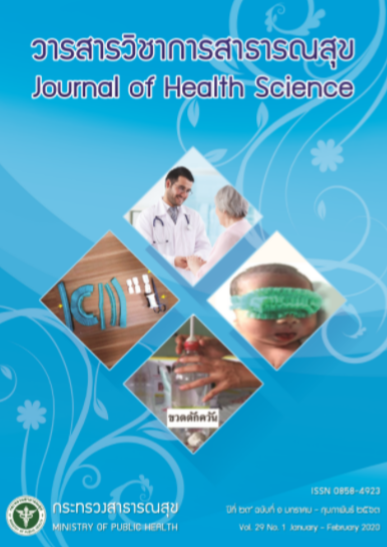Development of Occupational Health Nursing Model in Environmental Pollution Risk Areas
Keywords:
model development, occupational health nursing, environmental pollutionAbstract
This research and development aimed to develop and evaluate the outcomes of implementing the occupational health nursing model in environmental pollution risk areas, Chachoengsao province by applying the concept of case management. The study consisted of 4 phases: (1) situation analysis, (2) development of the occupational health nursing model, (3) tryout and modification, and (4) outcomes evaluation. A sample of 23 registered nurses and 382 people in environmental pollution risk areas was recruited using purposive sampling technique. The research instruments were checked for the content validity by 5 experts and composed of the occupational health care model in the environmental pollution risk area and a manual to educate people on health care from environmental pollution. The data collection tools consisted of: (1) knowledge test of registered nurses (KR-20=0.083), (2) satisfaction questionnaire of registered nurses towards the model (alpha coefficient=0.72), (3) opinion questionnaire of registered nurses towards the model (alpha coefficient=0.87) (4) knowledge test of people (KR-20=0.85), (5) satisfaction questionnaire of people (alpha coefficient=0.92), and (6) a record form on the number of people having access to services and receiving continuous care. Data were analyzed using percentage, mean, standard deviation and paired t–test. It was found that the developed occupational health nursing model in environmental pollution risk areas are consists of (1) setting qualifications and roles of the nurse case manager, (2) case management process, (3) guidelines for occupational health services in environmental pollution areas, and (4) care plans for different groups of people. The results revealed statistically different of the mean scores on the nurses’ knowledge before and after using the developed model (mean±SD=7.13±0.69 and mean±SD=8.26±0.92, respectively), yielding significant level of 0.05. The opinions and satisfaction of the registered nurses towards the developed model were at a high level (mean±SD=3.89±0.55 and mean±SD=4.12±0.78, respectively). There was also statistically different on the average score of the people’s knowledge before and after using the model (mean±SD=6.08±1.80 and mean±SD=8.07±1.47, respectively) yielding significant level of 0.05. The people’s satisfaction was at the high level (mean±SD=4.08±0.83). For the quality aspect, all the people had access to the services 100%, with 67% were normal, 31% were risk groups and 2% received continuous care.
Downloads
Downloads
Published
How to Cite
Issue
Section
License
Copyright (c) 2020 Journal of Health Science - วารสารวิชาการสาธารณสุข

This work is licensed under a Creative Commons Attribution-NonCommercial-NoDerivatives 4.0 International License.





